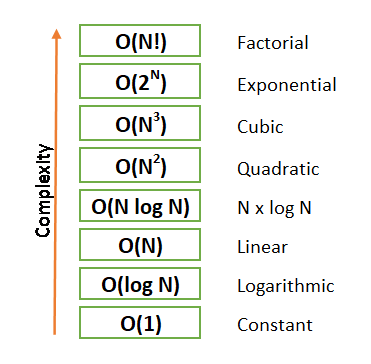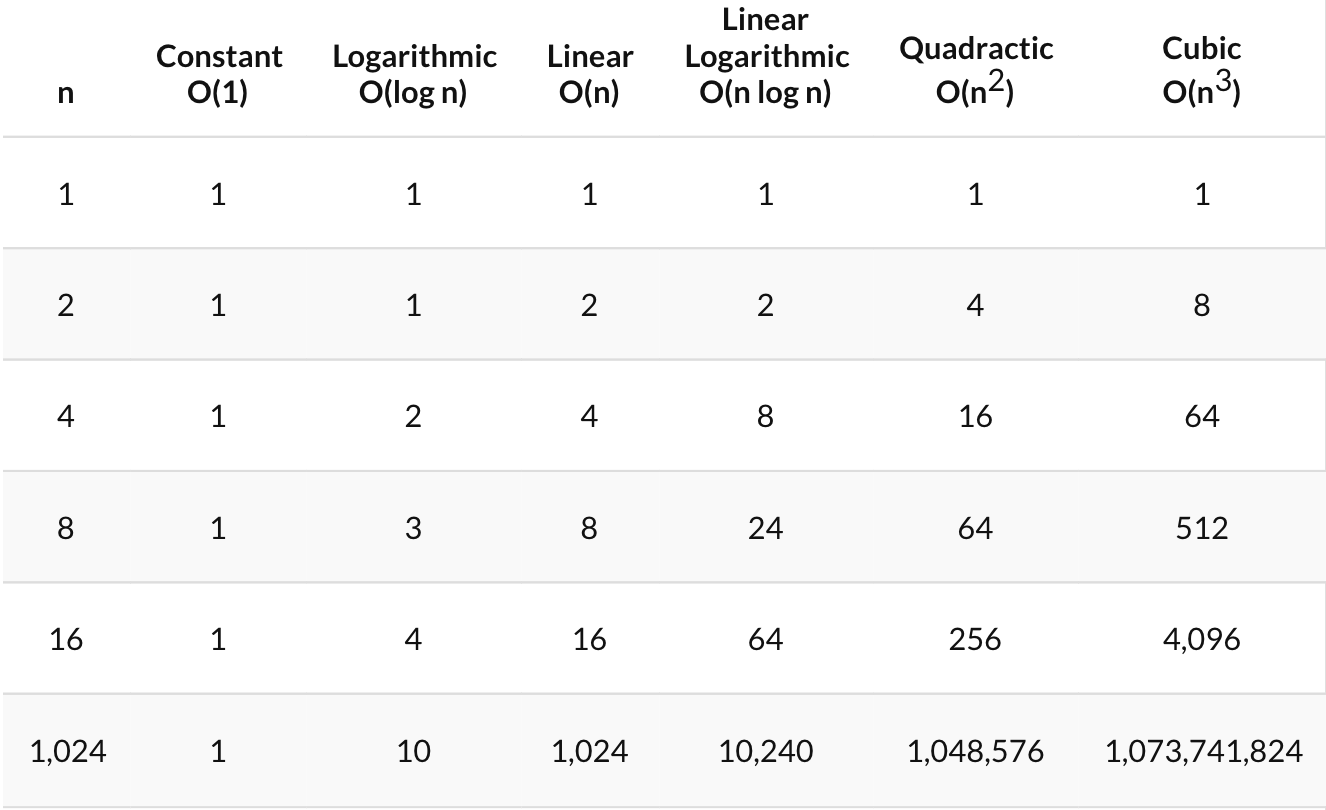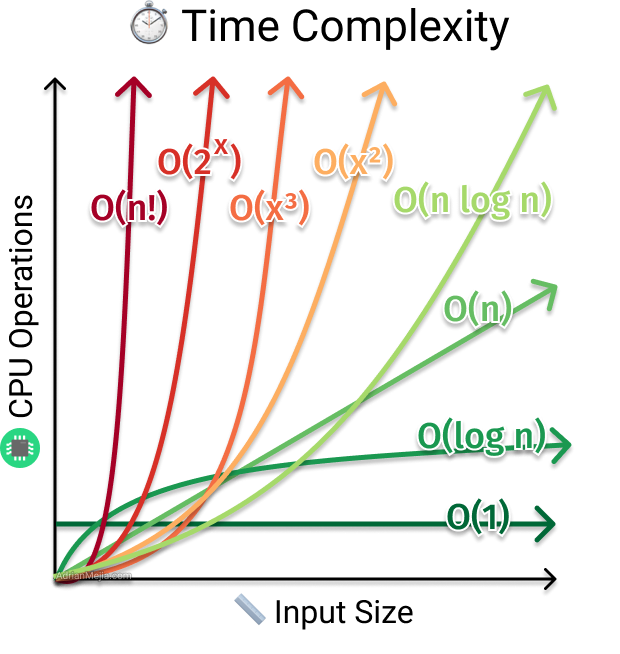How to Describe the Order of Magnitude Using Big O
Algorithms Order Of Growth. 1 N2 3N my answer O N2 2 3N2 N my answer O N2 3 N5 100N3 245 my answer O N5 4 3Nlog2N N2 my answer O N2 5 1 N N2 N3 N4 my answer O N4 6 N N 1 2 - my answer O N2 Am I doing this right.

Big O And Related Notations In Latex Texblog
1 N N2 N3 N4.

. Describe the order of magnitude order of growth of each of the following functions using single term Big- notation. Like the geese you see in the sky the order of magnitude is bigger than O 0. The Big O notation the theta notation and the omega notation are asymptotic notations to measure the order of growth of algorithms when the magnitude of inputs increases.
If we had an algorithm that did 7 n 4 35 n 3 - 19 n 2 3 operations its big-O notation would be O n 4. If however an algorithm runs in the order of 2n replacing n with cn gives 2cn 2cn. Using Big O notation the running time of an algorithm or program can be expressed in terms of the following.
The order of magnitude can be any integerThe table below. Where is Big O Notation Used. For a problem of size N.
The function f n provides a simple representation of the dominant part. Describe the order of magnitude of each of the following functions using Big-O notation. It provides a useful approximation to the actual number of steps in the computation.
O1 A linear-time functionmethod is order N. So we can say in big O notation that fx O1 as x 0. ON 2 Definition.
We can express algorithmic complexity using the big-O notation. Where. This can be written as c2n2 O n2.
A function TN is. When the bacteria in a flask have multiplied from some hundreds to. These notations big O big omega theta simply say how does the algorithm will be difficult or complex asymptotically when things will get bigger and bigger.
You measure the growth rate of an algorithm by the number of operations it takes to complete. You dont directly measure the speed of an algorithm in seconds. Generally the order of magnitude of a number is the smallest power of 10 used to represent that number.
A constant-time functionmethod is order 1. Orders of magnitude. It provides a useful approximation to the actual number of steps in the computation.
To work out the order of magnitude of a number the number is first expressed in the following form. A n2n1 b 3n2 3n 3 c n6 50n 100n1 150n3 200n2 250n 300 d n n2 n25 e 2nlog2n2n2 This problem has been solved. Lets verify 10 5 10 3 100000 1000 101000 101 10 5 ie the order of magnitude is 5.
Describe the order of magnitude of each of the following functions using Big-O notation. If we had an algorithm that did 2 n 5 operations the big-O notation would be O n. A decrease of two orders of magnitude is the equivalent of multiplying by 001 or 10-2.
Order of magnitude analysis. Many pretentious writers have begun to use the expression orders of magnitude without understanding what it means. The resultant order-of-magnitude will be the highest order which is added ie here the resultant order of magnitude will be 5.
F x and g x where f x O g x then you can say that you are able to find one x. Let g and f be functions from the set of natural numbers to itself. Order of magnitude is often called Big-O notation for order and written as O f n.
A function fx is Ogx if there exist two positive constants c and k such that fx cgx x k. This answer is not useful. On the other hand when.
Find the order of magnitude of the. Describe the order of magnitude of each of the following functions using Big-O notation. About Press Copyright Contact us Creators Advertise Developers Terms Privacy Policy Safety How YouTube works Test new features Press Copyright Contact us Creators.
In the above example T n1n. The function f n provides a simple representation of the dominant part of the original T n. For big O having two functions.
A quadratic-time algorithm is order N squared. Order of magnitude is often called Big-O notation for order and written as O f n. Its the method through which we assess the efficacy of various approaches to an issue.
ON A quadratic-time functionmethod is order N squared. The concept derives from the scientific notation of very large numbers in which each order of magnitude is ten times the previous one. Order of magnitude is the quantity of powers of 10 that there are in a number or the number of powers of 01 in a negative number.
A n n 10n b nºlogn nº n c 10n2 20n4-5 d nn-3nº - 4n2 4 e nº n 1 n 4 f 10n 7n2 5n 2n n5 2. The Big O is a little name for order of magnitude. Thus 2315 is one order of magnitude larger than 2315 which in turn is one order of magnitude larger than 2315.
You should Big O notation when performance among developers. Show activity on this post. As values get smaller a decrease of one order of magnitude is the same as multiplying a quantity by 01.
By the way O 0 means 100 which equals 1. Order of magnitude is usually written as 10 to the n th power. For example if an algorithm runs in the order of n2 replacing n by cn means the algorithm runs in the order of c2n2 and the big O notation ignores the constant c2.
In the previous article performance analysis you learned that algorithm executes in steps and each step takes a constant time. Big O notation is widely used in many areas of mathematics including calculus complexity theory and computer science. It is expressed in the form O n where O stands for order of magnitude and n denotes the tasks difficulty.
C and k are witnesses to the relationship that fx is Ogx. This is because when N gets large enough constants and low-order terms dont matter a constant-time algorithm will be faster than a linear-time algorithm which will be faster than a quadratic-time algorithm. And thats really the important thing to understand.
ON2 Note that the big-O expressions do not have constants or low-order terms. If there is one pair of witnesses ck then there are infinitely many c k. To describe the order of magnitude of a function we use Big-O notation.

Learning Big O Notation With O N Complexity Dzone Performance

Big O Notation Definition Examples Studiousguy

Introduction To Big O Notation Getting Started With Big O Notation By Andrew Jamieson Towards Data Science
No comments for "How to Describe the Order of Magnitude Using Big O"
Post a Comment